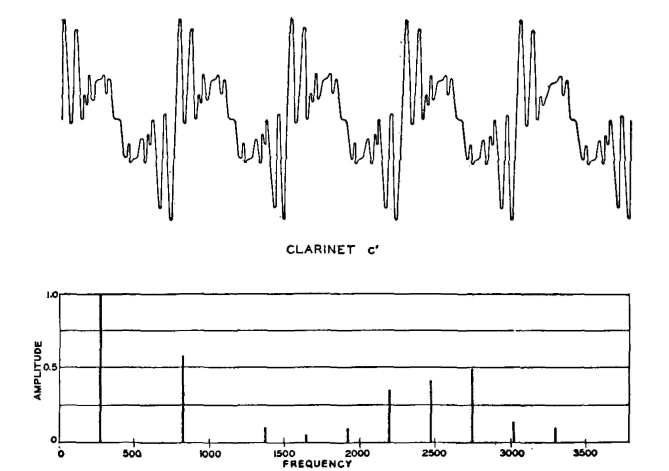| Electrical Communication is a free textbook on the basics of communication technology. See the editorial for more information.... |

|

Home  Fundamentals of Acoustics Fundamentals of Acoustics  Music Music |
|||||||||






|
|||||||||
MusicThe production of sounds by musical instruments depends on the action of the two principal parts of the instrument, the generator and the resonator. The function of the generator is to produce the tones. The resonator selects certain of these tones by resonant action and radiates them into the air. The vibrating string of a violin radiates very little sound directly. The amount radiated by the body of the instrument with which the string is in mechanical contact, however, is considerable. Musical instruments may be classified into two major groups: first, those employing vibrating strings; and second, those having vibrating air columns. The piano and violin are examples of vibrating string instruments, and organ pipes and horns are typical of the second class. A third possible class of musical instrument is the percussion type of which the snare drum and cymbals are examples. There are present, in any musical note, a large number of overtones, or harmonics. The frequency of the fundamental vibration determines the pitch; and the number, distribution, and relative intensity of the harmonics determine the quality of a note. It is this quality characteristic, depending as it does on the harmonics, which causes a note struck on a piano to be more pleasing and "richer" than a tone of the same fundamental frequency produced by a tuning fork or a vacuum-tube oscillator and loudspeaker. As an example, Fig. 11 shows both the wave form and the acoustic spectrum for a clarinet. The range of the fundamentals for musical instruments is as low as 16 cycles per second for an organ pipe, and as high as 4600 cycles for certain high-pitched instruments such as the piccolo. The values just given are, as mentioned, for the fundamental frequencies only. The harmonics of musical instruments are of course very much higher in frequency. Investigations26 have shown that they go at least to 15,000 cycles (see Fig. 12). In addition to a wide frequency range, music is characterized by wide changes in intensity. A 15-piece orchestra may have sound variations as great as 100,000 to 1 (50 db), during the rendition of a selection, and a very large orchestra will have even greater variations.
An extensive study26,27 was made to determine the frequency band and volume range that should be provided in the cable circuits for interconnecting radio broadcasting stations for musical programs. As a result of this investigation it was found that very little quality was lost if a band from 50 to 8000 cycles was transmitted, and if a volume range of 10,000 to 1 (40 db) was provided. In these tests the observers were trained musicians who noted when a change in the quality of the musical sounds was apparent.
A very interesting study was reported28 in 1945. The observers were average radio listeners, and they recorded their preference when listening to narrow-, medium-, and wide-frequency-band transmission. The narrow-band system transmitted from about 120 to 4000 cycles, the medium-band system from about 60 to 6000 cycles, and the wideband system from about 30 to 10,000 cycles. As a result of this study the conclusions were drawn28 that (1) the listeners preferred either a narrow or medium tonal range, and (2) most listeners still preferred a narrow to a wide tonal range, even when informed that one condition was low fidelity and that the other was high fidelity. This article has caused much discussion (Proc. I.R.E., October, 1946, p. 757). A study with "live" talent instead of music from loudspeakers indicates that listeners prefer wide-band music. (See "Frequency Range Preference for Speech and Music" by H. F. Olson, Electronics, August, 1947.)
|
|||||||||
Home  Fundamentals of Acoustics Fundamentals of Acoustics  Music Music |
|||||||||
Last Update: 2011-05-30



